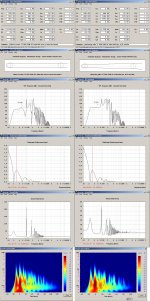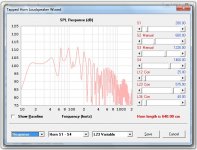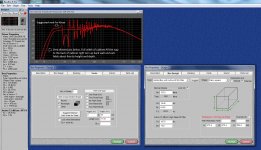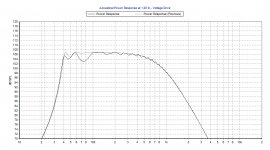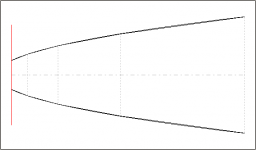If I set Ang to 0.5, and run "System design with driver", setting the frequency limits to 40Hz and 200Hz, I end up with a total volume of 532 litres. Perhaps you forgot to set the lower frequency to 40Hz? Because using the default values gives you a 2700 litres box.
I get the same 532 litres when I use System Design > With Driver and 40Hz - 200Hz, but if I try it with 20Hz - 50Hz for sub only use I get 4,339 litres.
I also notice it changes it from TH to Nd (whatever that may be)
Last edited:
I get the same 532 litres when I use System Design > With Driver and 40Hz - 200Hz, but if I try it with 20Hz - 50Hz for sub only use I get 4,339 litres.
I also notice it changes it from TH to Nd (whatever that may be)
If you want a horn to go to 20Hz, you just have to accept that it either will be huge, or will have resonances. That's just how the physics works... But by experimenting with areas and lengths, you can reduce the size somewhat. Unless you have lots of space and/or can build the horn into the house, a 20Hz full-size horn subwoofer is just a dream... Remember that for loudspeakers you can't get more than 2 out of 3 of
* high efficiency
* good low frequency extension
* small size
Nd means number of drivers. Double-click in the Nd box to change the driver configuration. (or use Tools -> Driver Arrangement).
-Bjørn
So am I right in assuming that TH is not really the right cabinet for sub work then?
Why not.
b
Attachments
I believe I may have been a bit hasty in that call... Although it is 577 litres compared to just a 103 litres of a BR cabinet, the tuning does seem a fair bit lower. (using LMS Ultra 5400 data as that is the planned sub drivers)Why not.
b
Attachments
Dear Mr. McBean
I think this is the third time I've made this request and I'm sure I'm not the only one. You are probably sick of hearing it by now but please let us have more segments.
IIRC the last time this was formally discussed, you didn't see any way to add more segments without messing up the format of the input screen. I think you mentioned that Akabak was available if we wanted to simulate more sections.
But since Hornresp has been able to simulate PAR sections and Akabak can't it's become undesirable to rely on Akabak.
Here is a suggestion on how it can be done without changing the input window. Below is a picture of Hornresp, I've circled Ap1. Clicking Ap1 changes the label and context of those input boxes.
What I propose is clicking on S1 in the same way, and having that switch the segment input section to display S5 - 10. In that way you could allow infinite segments without changing the look of the input window at all. Every time you fill up the available segments, double clicking the segment label would give you more segments. Once you stop adding segments, double clicking the segment label would go back to S1 and subsequent double clicks would scroll through all the defined segments. Hope that makes sense.
Please consider it. But even if you don't, thanks so much. I love Hornresp.
I think this is the third time I've made this request and I'm sure I'm not the only one. You are probably sick of hearing it by now but please let us have more segments.
IIRC the last time this was formally discussed, you didn't see any way to add more segments without messing up the format of the input screen. I think you mentioned that Akabak was available if we wanted to simulate more sections.
But since Hornresp has been able to simulate PAR sections and Akabak can't it's become undesirable to rely on Akabak.
Here is a suggestion on how it can be done without changing the input window. Below is a picture of Hornresp, I've circled Ap1. Clicking Ap1 changes the label and context of those input boxes.
What I propose is clicking on S1 in the same way, and having that switch the segment input section to display S5 - 10. In that way you could allow infinite segments without changing the look of the input window at all. Every time you fill up the available segments, double clicking the segment label would give you more segments. Once you stop adding segments, double clicking the segment label would go back to S1 and subsequent double clicks would scroll through all the defined segments. Hope that makes sense.
An externally hosted image should be here but it was not working when we last tested it.
Please consider it. But even if you don't, thanks so much. I love Hornresp.
Last edited:
SS, looking at the attachments in your post with the Bass Box Pro design. You do have a box that is 104 litres.
However, unless I'm reading it wrong, you also seem to have a port that is 4936mm long with a diameter of 274.2mm. This is an extra 291 litres of port
However, unless I'm reading it wrong, you also seem to have a port that is 4936mm long with a diameter of 274.2mm. This is an extra 291 litres of port
... But since Hornresp has been able to simulate PAR sections and Akabak can't it's become undesirable to rely on Akabak. ...
As you point out, Hornresp has a limited number of sections available. AkAbak allows many. Define a series of waveguide sections with dimensions following the parabolic law. Close enough for rock'n'roll...
Sure, it's possible and not even that hard, but are you really voting against more segments?
While not terribly difficult, the method you describe requires quite a bit of time, every time, for every segment of every model.
I'm guessing the proposed upgrade would be a lot simpler to implement than a lot of the recent upgrades so I had to ask again.
While not terribly difficult, the method you describe requires quite a bit of time, every time, for every segment of every model.
I'm guessing the proposed upgrade would be a lot simpler to implement than a lot of the recent upgrades so I had to ask again.
Last edited:
SS, looking at the attachments in your post with the Bass Box Pro design. You do have a box that is 104 litres.
However, unless I'm reading it wrong, you also seem to have a port that is 4936mm long with a diameter of 274.2mm. This is an extra 291 litres of port
I believe you are reading that correctly, but that is only if you are trying to reach Xmax you need a port that size, if you look at the attached pic you will see that you can achieve decent SPL with a much smaller port, that probably only adds 4cms to the height and length.
You will also notice in post 2856 at 30Hz (280 litres) I had a SPL of 110dB, where as in post 2863 you will notice NEO Dan went up to 326.5 litres to achieve 20Hz with an SPL of only 92.5dB (both using the Pro 5100)
But here's the catch... even though HR models a much larger box, no matter how much volume I throw at the BR in BBP it wont go as low as the model in post 2866.
So until such time as BBP adds horn functions to its products I have to look at alternatives even if they are less user friendly.
I am finding it easier to use, but still feel like I am twiddling knobs with understanding why, would still like to see a more comprehensive and modern help file that explains what takes place when I alter this slider or that slider.
A 500 litre box may not even be that big of an issue. I am looking to build the sub into a couch or chair to hide it in the room.
Attachments
Sure, it's possible and not even that hard, but are you really voting against more segments?
No, far from it. I've had occasions where I could have done with one or two more segments in Hornresp.
While not terribly difficult, the method you describe requires quite a bit of time, every time, for every segment of every model. ...
Not if you have a utility for calculating the segments.
please let us have more segments.
Hi just a guy,
The way that Hornresp is structured, the addition of more segments would require a complete re-write of the program. This is not something that I am in a position to do.
It is important to keep things in perspective, though. For bass horns, it is possible to get a pretty good indication of performance by approximating any design using the four segments available in Hornresp. The wavelength at 100 hertz is 3.44 metres, and differences of a centimetre or two from the desired profile are unlikely to have a significant impact on predicted response. A number of users have commented on how closely Hornresp results compare to AkAbak predictions even when many more segments have been used in AkAbak to define the profile.
Kind regards,
David
For bass horns, it is possible to get a pretty good indication of performance by approximating any design using the four segments available in Hornresp. The wavelength at 100 hertz is 3.44 metres, and differences of a centimetre or two from the desired profile are unlikely to have a significant impact on predicted response.
As an example of this, see the attached plot. Both are for a 40Hz exponential horn, S1 = 95, S2 = 31000, L12 = 441, ANG = 2 pi. The gray curve is the response when the horn is approximated by 50 conical elements. The black curve is for the same horn approximated by two conical elements. The deviation is at most 3.5dB. This would depend on the driver, though, but the differences between the actual profiles are quite large.
-Bjørn
Attachments
Hi just a guy,
The way that Hornresp is structured, the addition of more segments would require a complete re-write of the program. This is not something that I am in a position to do.
Thanks for the answer, I guess that's the end of that.
It is important to keep things in perspective, though. For bass horns, it is possible to get a pretty good indication of performance by approximating any design using the four segments available in Hornresp. The wavelength at 100 hertz is 3.44 metres, and differences of a centimetre or two from the desired profile are unlikely to have a significant impact on predicted response. A number of users have commented on how closely Hornresp results compare to AkAbak predictions even when many more segments have been used in AkAbak to define the profile.
Kind regards,
David
Hornresp does a lot better than "a pretty good indication".
But in reality there's only 3 usable segments to define the horn shape. Most (all?) bass horns are offset so a segment has to be wasted as a location placeholder for the driver.
If there was a way to gain back even just that one segment by defining driver position in a different way than using a segment, even that one segment would help.
But I'll let the segment dream die now, there's always Akabak and I still love Hornresp.
Thanks.
Last edited:
As an example of this, see the attached plot. Both are for a 40Hz exponential horn, S1 = 95, S2 = 31000, L12 = 441, ANG = 2 pi. The gray curve is the response when the horn is approximated by 50 conical elements. The black curve is for the same horn approximated by two conical elements. The deviation is at most 3.5dB. This would depend on the driver, though, but the differences between the actual profiles are quite large.
-Bjørn
I'm not sure about this. A 40Hz exponential horn can be completely defined by 1 segment. 50 segments adds no extra information?
Or am I missing something here?
You need more segments if you want to model things like expansion chambers, or straight parts of the pipe, or at a bend in the enclosure (where you would model a slight expansion), or experimenting with putting stuffing in some sections and not others. Etc. etc etc.
If there was a way to gain back even just that one segment by defining driver position in a different way than using a segment, even that one segment would help.
Suggestion: The throat adapter is in effect a 5th segment. It is always conical, but that should be a minor issue. If it was possible to specify that the throat adapter should be the first segment in an otherwise offset horn, we would gain back that first segment for use in the main part of the horn.
-Bjørn
I'm not sure about this. A 40Hz exponential horn can be completely defined by 1 segment. 50 segments adds no extra information?
True, an exponential horn can be completely defined by a single exponential segment (or element). In the example shown, however, the exponential profile is approximated by 50 conical segments in one case, and 2 conical segments in the other. The idea was to show that even the extremely coarse 2-segment approximation was not that far off. (50 conical segments is very close to a single exponential).
You need more segments if you want to model things like expansion chambers, or straight parts of the pipe, or at a bend in the enclosure (where you would model a slight expansion), or experimenting with putting stuffing in some sections and not others. Etc. etc etc.
That is correct. And there are other reasons for using many conical elements instead of a single exponential as well. One case is where you don't want to use the plane wave assumption, which is inherent in the equations for finite horns given by for instance Olson. Instead you use a series of elements where the lengths and areas are based upon the expansion of the curved wave front.
Another case is when you want to model horns that do not have (simple) analytic expressions for pressure and volume velocity, like the LeCleac'h or tractrix horns.
-Bjørn
Related to the recent discussion about parabolic profiles, the attached picture shows two superimposed schematic diagrams from Hornresp. One of the horns is a single parabolic segment. The other curve is the same horn made from 4 conical segments. In summary, "close enough for rock'n'roll".
Attachments
- Home
- Loudspeakers
- Subwoofers
- Hornresp
